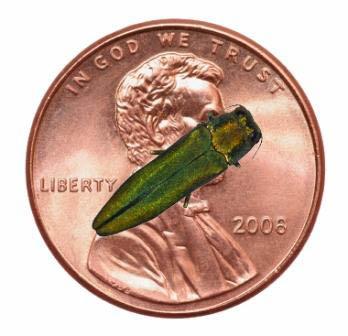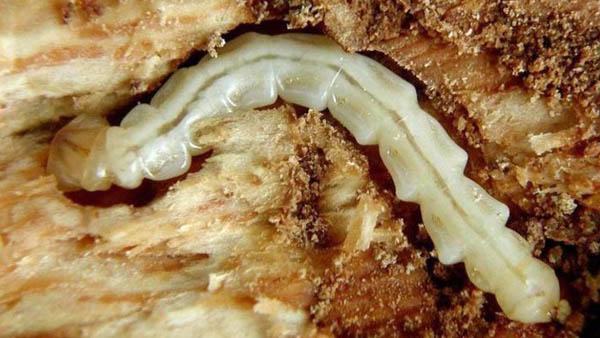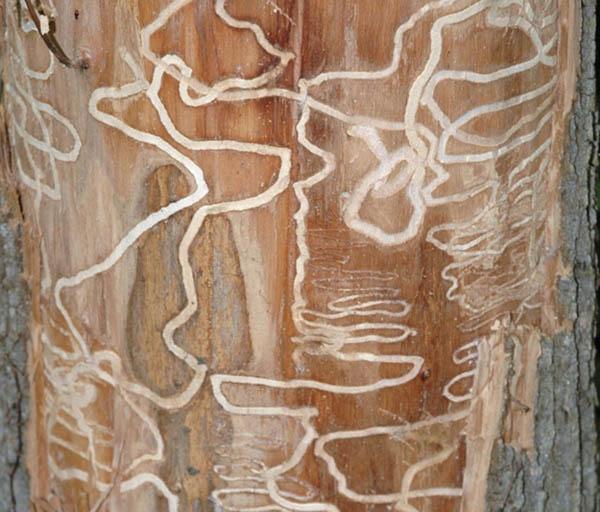There was a day not that long ago when Randy Wilson couldn't wait to jump on a story about damage caused by the emerald ash borer because he thought the name of the tiny, destructive pest sounded indecent.
 I'm not sure what obscenities rhyme with "emerald", but the devastation caused by this feral invader from Asia no longer is a laughing matter in Georgia, or, for that matter, nearly two-thirds of the rest of the country.
I'm not sure what obscenities rhyme with "emerald", but the devastation caused by this feral invader from Asia no longer is a laughing matter in Georgia, or, for that matter, nearly two-thirds of the rest of the country.The emerald ash borer's range once was confined to Ontario and a handful of states that ringed the Great Lakes, but no more. Today, there are confirmed sightings in three provinces in Canada and 31 states, including Georgia. Eight other states, where the threat is perceived as imminent, have made information available about what to do if you spot one.
Few if any people on this continent had ever heard of the emerald ash borer two decades ago. Since the first ones entered Detroit aboard a cargo ship 16 years ago, the pest has wiped out billions of trees causing billions in damage. Much of that damage has been on golf courses, and likewise has affected the game of baseball. The wood bats used by major leaguers for decades are crafted from white ash, and EAB's presence is threatening that industry.
Baseball legend Ty Cobb - a Georgia native - would not be amused.
Native to parts of eastern Asia, the EAB borer burrows into ash trees as an adult where it lays its eggs. The larvae feed on the layer beneath the bark, disrupting the tree's vascular system and its ability to take up water and nutrients and eventually kill the tree.
The ash borer's current range has increased dramatically, according to the web site emeraldashborer.info, and borders Colorado to the west, Texas and the Gulf Coast to the South, the Atlantic to the East and north all the way to New Hampshire. It is found in Canada in Ontario, Quebec and most recently Manitoba. The EAB web site is a news and information portal that is a cooperative effort between Michigan State, Purdue and Ohio State universities, the Michigan and Ohio departments of Agriculture; the Michigan, Indiana and Ohio departments of Natural Resources; the USDA Forest Service; the USDA Animal and Plant Health Inspection Service (APHIS); and the Canadian Food Inspection Agency.
That's a long way for such a small bug to travel. It has had help by those who, by moving infested firewood, have unwittingly violated U.S. Department of Agriculture quarantines.

Think ash borers aren't a big deal for some golf course superintendents? Think again.
Dead and dying trees are more than an eyesore. They are a safety hazard and a legal liability if someone was injured by a falling bough or branch.
The bug has affected golf courses throughout its adopted range. Racine County, Wisconsin has padded the operating budget of its two courses to evaluate, treat and remove infected trees. At least 35 trees there were removed last year, and nearly 100 more are scheduled to be removed.
It's the same story at Hickory Sticks Golf Course in Van Wert, Ohio, where superintendent Mike Fast said 20 trees have been cut down. He plans to take down at least 50 more. At Bowling Green State University, an hour north of Van Wert, the school's golf course lost nearly 200 trees to the ash borer before closing its doors last year.
 Scientists believe that the pest eventually will reach the entire ash tree range in North America, an area that covers parts of at least 42 U.S. states and six provinces in Canada. Each ash borer, however, only flies a few miles throughout its lifecycle, so moving firewood, or not, is critical to controlling its spread.
Scientists believe that the pest eventually will reach the entire ash tree range in North America, an area that covers parts of at least 42 U.S. states and six provinces in Canada. Each ash borer, however, only flies a few miles throughout its lifecycle, so moving firewood, or not, is critical to controlling its spread.EAB kills ash trees by disrupting the uptake of water and nutrients through the trunk and into the upper reaches of the tree.
Adult females, which grow to about a half-inch in length, create a hole in the bark into which they deposit their eggs. After hatching, the larvae feed on and chew galleries through the tissue beneath the bark layer. In the spring, new adults chew through the bark and emerge leaving behind a D-shaped exit hole before flying into the canopy to ingest ash leaves and the reproductive process begins all over again.
Symptoms of infestation include thinning of the canopy and sprouts growing from holes in the trunk that were created by the pests, along with an scores of hungry woodpeckers that eat them. According to the Ohio Department of Agriculture, canopies of mature ash tree typically are decimated within two years of infestation and the trees dead within five years.
Tree canopies can be wiped out within two years, and mature, healthy trees typically are dead within three to four years. All native North American ash species are susceptible to damage.
During the past several years, the U.S. Department of Agriculture has been studying and raising non-stinging parasitic wasps from Asia to help control EAB.
Four species of wasp, Spathius galinae, Oobius agrili, Spathius agrili and Tetrastichus planipennisi have proven to be effective at parasitizing 50-90 percent of the target EAB ova or larvae.
The wasps are raised at the USDA Animal and Plant Health Inspection Service facility in Michigan.


